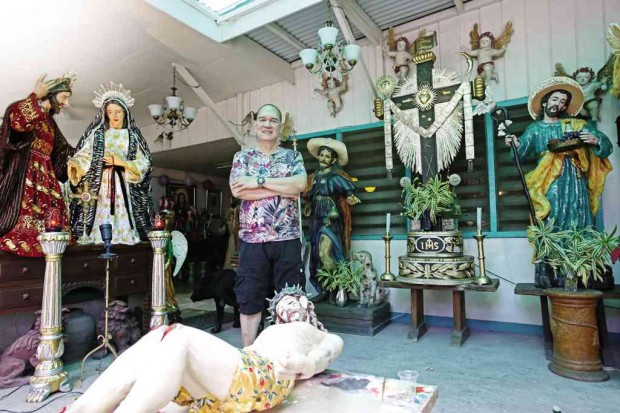
LOUIE Nacorda’s collection of religious art started from an image of the Sto. Niño (Child Jesus) acquired in the 1960s. JUNJIE MENDOZA /Cebu Daily News
Heritage enthusiast Clodoveo “Louie” Nacorda loved to collect porcelain and heritage furniture so much that he simply scoffed at the idea of acquiring other things.
One day, he saw a peculiar image of the Sto. Niño, which stirred his interest: The left arm, instead of the usual right hand, was slightly raised in benediction. “It was left-handed and I was so enthralled by it,” he said.
His admiration to the unique icon of the Child Jesus prompted him to acquire a number of religious images and paintings.
That was in the 1960s, and since then, his collection grew that Nacorda stopped counting.
“Probably, I have over a hundred religious images and more than 50 paintings,” said Nacorda, who worked as assistant manager of a now-defunct shipping company in Manila before going home to Cebu City in 1991.
Nacorda, 65, owns different tableaux depicting Jesus’ sufferings and death, as well as the characters in the Passion of Christ.
Priests and bishops who visit his two-story house in Barangay Guadalupe in Cebu City are even awed at his collection—all created by Filipino carvers and artists.
“Collecting religious images is absolutely different than anything else. It simply seeps through the soul. It touches you and, at times, brings you to tears,” he said.
House items
At the lobby of his house is a life-size image of St. Michael the Archangel thrusting Satan into hell. Outside are wooden icons of the Blessed Virgin Mary,
St. Joseph, St. John the Baptist and about 20 other religious images.
Inside is an old ivory carving of the Our Lady of the Immaculate Conception, which is used during the annual Dec. 8 procession at Cebu Metropolitan Cathedral.
Nacorda, who heads the project finance committee of Cebu Metropolitan Cathedral, owns other icons used by churches during their feast days. Among these are the images of St. Vitalis and the Immaculate Conception, which he lends to the cathedral.
In the mid-1980s, Nacorda recalled that except for an image of Jesus the Nazarene, the parish church in Guadalupe did not have any other icons they could use during the Holy Week procession.
Heeding the call of the then parish priest, Nacorda commissioned the creation of several images to commemorate the agony of the Lord, as well as the other characters in the narrative of Christ’s Passion in the Bible.
Now, he has at least 30 of such images. He lends some to other churches during the Holy Week and keeps the rest in his house. Sometimes, he would show them in exhibits.
Education
“I want to educate people about the life of Christ. I hope… I could remind them of what Jesus went through to redeem us,”
Nacorda said.
“As devotees, we have the duty to let other people know about the lives of the persons represented by the images, so they, too, will be drawn to the Lord,” he added.
Nacorda’s collection include tableaux depicting Christ’s entry to Jerusalem, the Agony in the Garden, the Scourging at the Pillar, the Crowning with Thorns, the Carrying of the Cross and the Calvary scene.
He also keeps life-size images of St. Peter, St. Mary Magdalene, St. Mary Jacobe, St. Salome,
St. Photini or the Samaritan woman, and St. Longinus, the Roman soldier who pierced Jesus’ side with a lance, and a replica of the “Ecce Homo” or the bust of the suffering Christ to emphasize the Cebuano devotion to one of the baptismal gifts of Portuguese explorer Ferdinand Magellan to Cebu in 1521.
The original image of the
Ecce Homo is enthroned in a niche at the right side of the centuries-old Basilica del Sto. Niño in Cebu City’s downtown area.
Nacorda also has a handful of images of the dead Christ in different forms and sizes.
“We have to take good care of the sacred images. I don’t care what it’s made of. As long as it is a holy image, I would revere it,” he said.
Huge responsibility
Possessing religious icons entails a huge responsibility, not just in taking good care of it but also in propagating the Christian faith, Nacorda said.
“Inadvertently, I’m able to evangelize through visual arts. And through these religious and ecclesiastical icons, we glorify God,” he said.
Contrary to claims that Catholics worship icons, Nacorda said it had never been the case.
“Sacred images are actually just made of wood, stone and ivory. What matters is who they represent. As the doctrine of the Catholic Church repeatedly extol, we venerate these images because they represent holy people,” he said.
Since his collection could no longer fit in his house, Nacorda is renting a 70-square-meter condominium unit in Barangay Parian, also in the city, to accommodate the religious items. He is hoping to have three oratories to house his collection.
For those who want to collect religious images, Nacorda has this advice: “Don’t just collect religious images to imitate a neighbor. Before buying an image, first start the devotion. Build a relationship with the saints and the Lord.”